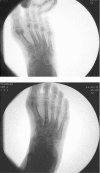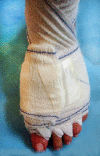Minimally invasive-percutaneous surgery - recent developments of the foot surgery techniques
- PMID: 26361518
- PMCID: PMC4564048
Minimally invasive-percutaneous surgery - recent developments of the foot surgery techniques
Abstract
Percutaneous techniques are currently more and more used in many surgical procedures on the soft tissues and bones of the foot. Practical advantages include lower complication rates and faster recovery times. Potential disadvantages are related to the need for specific equipment and extensive learning curve. One of the most frequent techniques involves a combination of chevron osteotomy of the first metatarsal with osteotomy of the first phalanx, both internally fixated. Lateral metatarsal misalignment and toe deformities can also be addressed by percutaneous treatment, with lower morbidity rates than open techniques. The most commonly performed percutaneous procedures are described, with their current indications, outcomes, and recent developments.
Keywords: foot surgery techniques; hallux valgus treatment; intermetatarsal angle; minimally invasive–percutaneous surgery; osteotomies.
Figures






References
-
- Leemrijse T, Valtin B, Besse JL. Hallux valgus surgery in 2005. Conventional, mini invasive or percutaneous surgery? Uni- or bilateral? Hospitalisation or one-day surgery? Rev Chir Orthop Reparatrice Appar Mot. 2008;94:111–127. - PubMed
-
- De Prado M, Ripoll PL, Golano P. Minimally Invasive Foot Surgery: Surgical Techniques, Indications, Anatomical Basis. Bilbao, Spain: About Your Health; 2009.
-
- Coillard JY, Laffenetre O, Cermolacce C, Determe P, Guillo S, Jambou S, de Lavigne C. Traitement chirurgical des métatarsalgies statiques par technique mini-invasive. 2e éd. Paris: Elsevier Ed.; 2005. pp. 89,153–157.
-
- Darcel V, Villet L, Chauveaux D, Grecmip group , Laffenetre O. Treatment of static metatarsalgia using distal percutaneous metatarsal osteotomy: a prospective study of 222 feet. Rev Chir Orthop. 2009;5:229–242.
-
- Maffulli N, Easley M. Minaimally Invasive Sugery of the Foot and Ankle. Spinger-Verlag; 2011.
Publication types
MeSH terms
LinkOut - more resources
Full Text Sources
Medical
